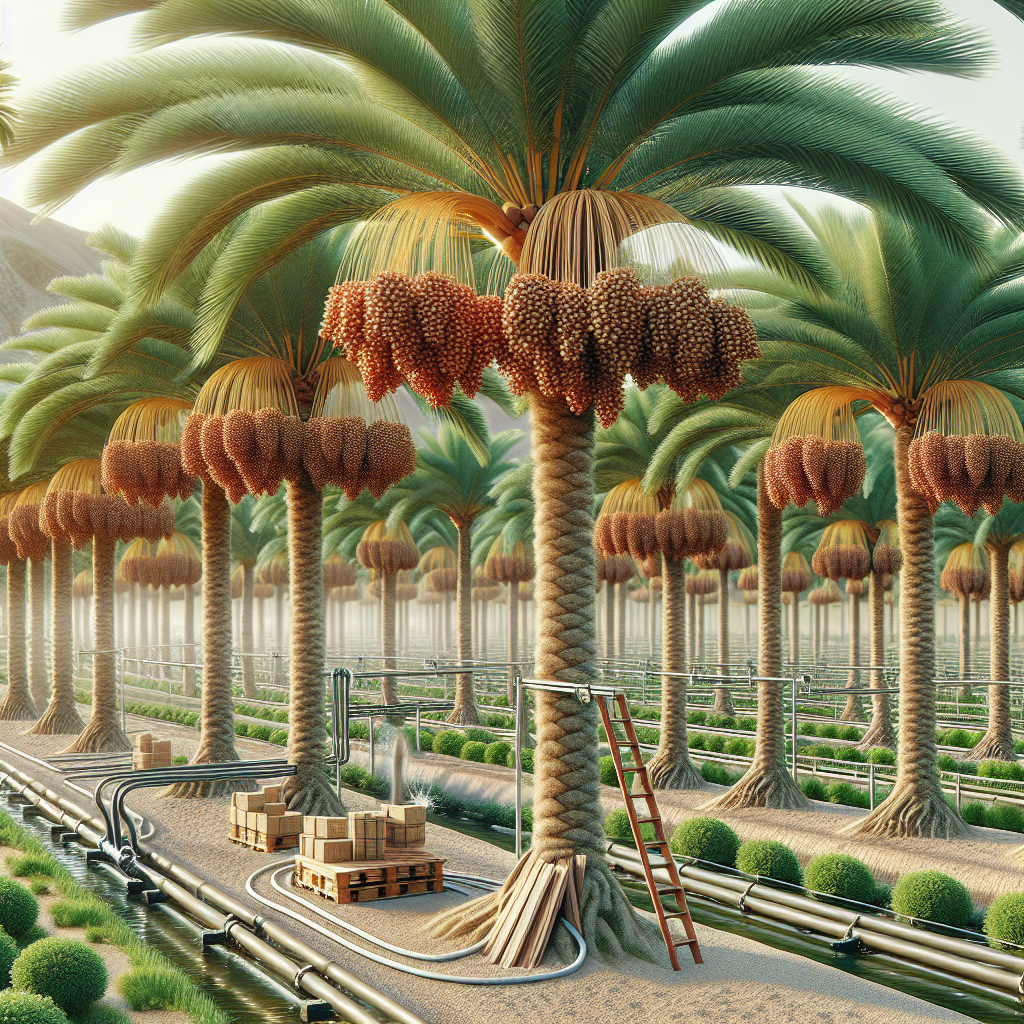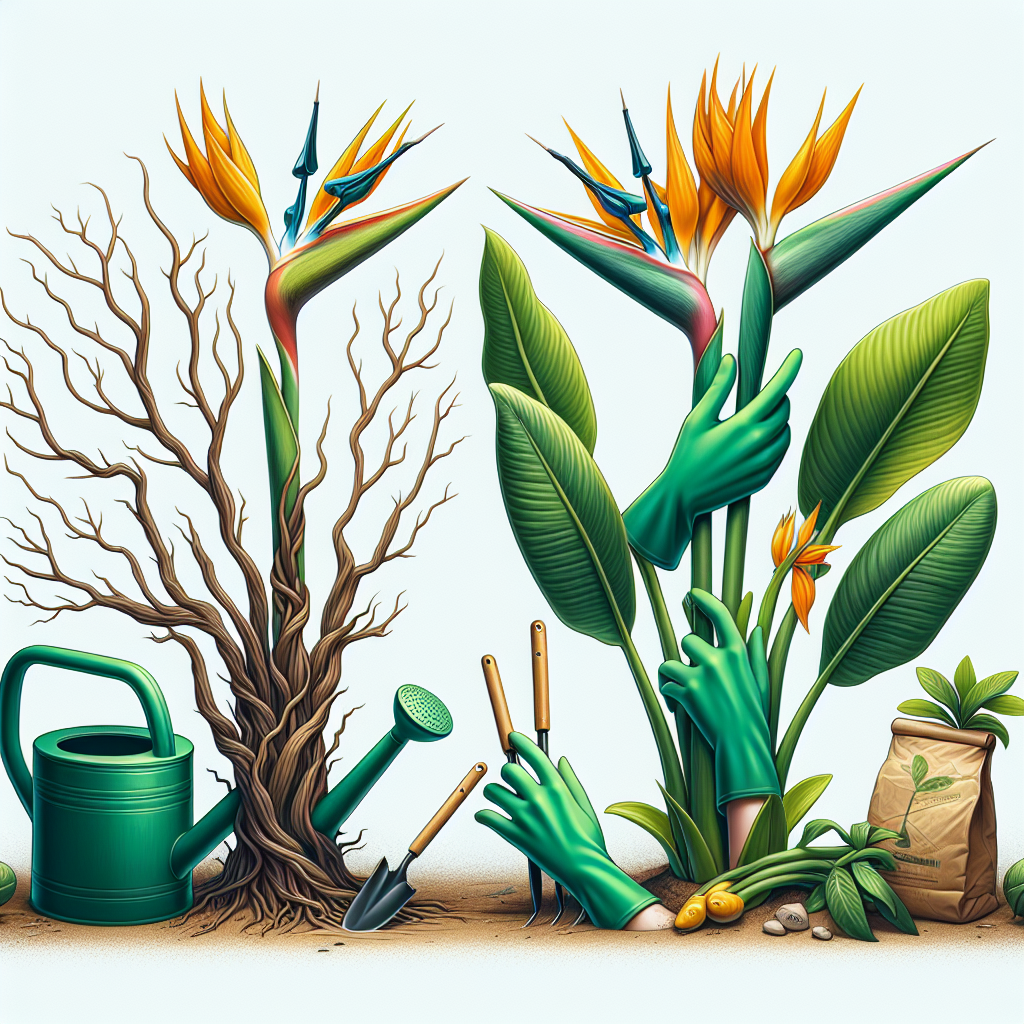Maximizing Fruit Production in Date Palms
Updated June 27, 2024 at 3:18 am

“`html
Overview of Date Palm Fruit Production
- Pet Friendly: Date palms are generally pet-friendly, but it’s essential to keep an eye on pets to prevent ingestion of large seeds which can be a choking hazard.
- Light Requirements: For optimal growth and fruit production, these trees require full sunshine.
- Watering: Regular and deep watering is crucial during the growing season, though mature palms are drought tolerant.
- Humidity: Date palms prefer dry, arid conditions resembling their native desert habitats.
- Temperature: These trees thrive in high temperatures and are sensitive to cold weather, particularly when young.
- Difficulty: While not particularly demanding, cultivating date palms for maximum fruit production requires specific know-how.
Optimal Soil Conditions and Planting Techniques
When it comes to planting date palms, the type of soil used is pivotal to ensure healthy growth. A well-draining sandy loam is ideal, as it resembles the palm’s native desert soil. It’s recommended to check the pH level, which should be around 8.0 for the best results. Establishing the palms in the right type of soil from the beginning sets the foundation for a fruitful future.
Planting should take place in the warmer seasons, allowing the roots to establish themselves before cooler temperatures arrive. It’s also beneficial to incorporate organic matter, like compost or aged manure, to provide the tree with ample nutrients. Remember, patience is key, as it can take anywhere from 4 to 8 years for the trees to begin producing fruit after planting.
Watering Requirements for Healthy Trees
Consistent watering is essential during the early stages of date palm growth. While adult palms can withstand drought, young plants need moisture to establish an extensive root system. Use a drip irrigation system to provide deep, consistent watering that encourages root development and, ultimately, fruitful production.
During the fruiting season, the amount of water should be increased to sustain the developing fruits. Overwatering, however, can be just as detrimental as under-watering, so it’s a balance that one might have to manage depending on climate and rainfall patterns.
Fertilization Strategies to Boost Productivity
Fertilizers play a vital role in maximizing fruit production. Palms have specific nutrient needs, especially nitrogen, potassium, and magnesium. Palm-specific fertilizers are available which cater to these requirements. It is advisable to fertilize at least twice a year, once before the growing season and once midway through.
Some excellent options in the market include Miracle-Gro Shake ‘n Feed Palm Plant Food, which ensures that the palms get a steady supply of nutrients for luscious growth and optimal fruiting. Reviewers love its ease of use and have noticed healthier fronds and improved fruit yield. This observation by many marks it as a solid recommendation for those looking to boost their date palm production.
Find This and More on Amazon
Pruning Techniques to Encourage Growth
Pruning is another crucial aspect of maximizing fruit production in date palms. Removing dead or dying fronds helps the tree conserve energy for fruit development. Additionally, thinning the number of fruit clusters can prevent the palm from overproducing, which could lead to smaller fruits.
Pruning should always be done with care to avoid damaging the tree’s crown, and always sanitize your pruning tools before and after use to prevent the spread of disease. As much as it might feel counterintuitive, strategic pruning is a friend in your date palm’s fruit production journey.
Pest and Disease Management
One might encounter pests such as scale insects, spider mites, or the dreaded Red Palm Weevil. Effective pest management often involves biological controls like beneficial insects and regular monitoring. For diseases, keeping an eye out for signs of Fusarium wilt or Bayoud disease is vital. Treatment usually involves cultural practices such as removing infected material and, in some cases, the use of specific fungicides.
One product that has garnered positive attention for pest control in palms is the Bonide Systemic Insect Control. It’s said that people say this systemic insecticide addresses various pest issues without harming the beneficial ones. This aspect has been highlighted in many user reviews as being particularly helpful and efficient.
Find This and More on Amazon
“`
Periodic Maintenance and Regular Observations
Maintaining the general health of date palms involves a diligent routine. Regular inspection of palms can help identify any arising issues early — such as nutritional deficiencies or signs of stress. Signs to look out for include yellowing leaves, which can suggest a lack of magnesium or potassium, or stunted growth, which may indicate a need for more nitrogen.
It’s also essential to clear the area around date palms of weeds and debris, which can harbor pests and diseases. This type of environmental management ensures your palms are living in optimal conditions to prevent problems that might otherwise stunt their growth or fruit production.
Harnessing the Best Harvesting Practices
Harvesting date fruits at the right time is key to maximizing production. The best time to harvest dates is when they reach the ‘rutab’ stage — where the fruit is ripe, soft, and full of flavor. Palms can yield large quantities of dates, but if harvested too early or too late, the quality may be compromised.
Using long-handled cutting tools can help you reach clusters safely. It’s essential to handle the fruit carefully to avoid bruising. Post-harvest, dates should be sorted and cleaned promptly to prepare for sale or consumption. This is where your hard work pays off, delivering a bounty of delicious dates from each palm.
Understanding the Climatic Impact on Date Palms
Although adaptable to a range of conditions, date palms have their climatic preferences. They love hot and arid environments — think desert-like conditions with minimal humidity. Therefore, it’s crucial to understand how your local climate can impact date palm growth and fruit production.
If you live in an area with higher humidity or rainfall, you might need to take extra steps to mimic the dry conditions date palms crave. This could involve using raised beds or mounds to improve drainage around the trees or protective covers during the wetter months.
Effective Use of Technology in Cultivation
Incorporating technology in date palm cultivation can lead to significant improvements in fruit production. For instance, soil moisture sensors can help you water your palms efficiently, providing just the right amount of moisture. On a larger scale, employing drones for aerial monitoring of the palms can give insights into the health and growth patterns of an entire orchard.
Smart farming tools, like climate stations, can assist in making better-informed decisions based on real-time data. This proactive approach to farming is not just about solving immediate issues but preventing potential challenges before they even arise.
Exploring the Roles of Cross-Pollination
Date palms are dioecious, meaning male and female flowers are on separate plants. For fruit production, pollination is a must — and understanding the process can vastly improve your yield. While natural pollination occurs through wind and insects, hand pollination techniques can ensure a higher success rate.
One can introduce pollen from males to female flowers manually or through mechanical methods like pollen sprayers. The key is to pollinate during the optimal time when the female flowers are receptive, which is typically in the early morning when humidity is lower.
Long-Term Strategies for Sustainability
For date palm growers looking at the long game, sustainability in farming practices is paramount. This involves everything from conserving water with efficient irrigation systems to using organic mulches for weed control and moisture retention.
In the bigger picture, it’s also about preserving the genetic diversity of date palms. Encouraging the cultivation of different varieties can not only lead to a more resilient farming system but also offer different types of dates for various market demands. Finding the balance between immediate fruit production and the long-term health of your date palms is the ultimate goal.
Conclusion and Content Area 3 of 3
The final text of the article should sum up and re-emphasize the importance of the various aspects discussed for maximizing fruit production in date palms, from soil conditions and watering requirements to pest control and harvesting practices. It is vital for readers who are serious about cultivating date palms to remember that patience and persistence, as well as a willingness to adapt techniques to their unique environment, are essential for success.
“`html
And so, we arrive at the essence of cultivating date palms: combining traditional knowledge with modern techniques for a bountiful harvest. Whether you are a seasoned grower or at the start of your agricultural journey, understanding the meticulous care that date palms require will set you on a path to success. Every aspect, from selecting the right soil to performing delicate pollination tasks, forms a link in a chain that leads to the ultimate reward of plump, sweet dates hanging from your very own trees.
Each detail, no matter how small it might seem, plays a significant role in fruit production. The consistency in watering, the precision in pruning, the attentiveness to climatic changes – all these factors demand your attention and energy. Yet, the return is not just in the quantity and quality of the fruit, but also in the sustainable practices that ensure these majestic trees can continue to thrive for generations to come.
Nurturing Your Orchard for Future Generations
Embarking on the adventure of date palm cultivation is a commitment to the future. Beyond the annual harvest, your efforts in maintaining a healthy orchard contribute to the preservation of this species, which has been intertwined with human history for thousands of years. By fostering a sustainable environment today, you are laying the groundwork for future farmers.
Remember, a thriving orchard of date palms is more than an individual accomplishment. It’s a legacy, a testament to the symbiotic relationship between humans and nature. In caring for these trees, you become part of a story much bigger than the sum of its parts – a story of survival, triumph, and the sweetness of success.
Embarking on Your Date Palm Journey
If you’re considering establishing your own grove of date palms, it’s crucial to absorb all the guidelines detailed in this discussion. Prepare to invest time, dedication, and patience. Cultivating date palms is not a swift journey, but the rewards – both tangible in the baskets of golden fruits and intangible in the satisfaction of nurturing life – are innumerable.
Picture the rows of towering palms in your care, each one representing the fruits of your labor. As you watch them grow and flourish, take pride in the knowledge that you have applied the best practices to maximize your date palm’s fruit production, ensuring that this ancient and revered tree continues to provide its bounty for today, tomorrow, and far into the future.
Sharing the Bounty: Date Palms’ Community Impact
Finally, it’s crucial to consider the broader impact your date palm orchard can have. This isn’t merely a solitary venture; it’s an opportunity to influence and contribute to your community. The production and sale of dates can stimulate local economies and offer nutritious food options.
From the solitary quiet of an early morning in your orchard to the bustling energy of a farmers’ market brimming with your harvest, the journey of cultivating date palms is full of growth, challenge, and reward. Let this be not just a guide, but an inspiration to delve into the world of date palms, to learn from the tree’s history, and to contribute to its future.
“`
Shop more on Amazon

